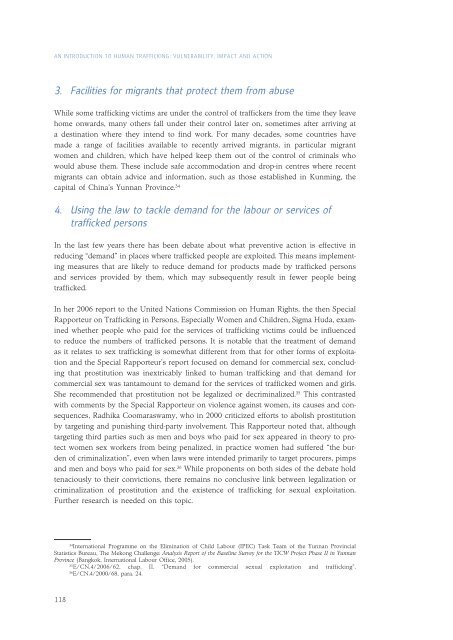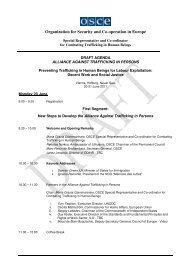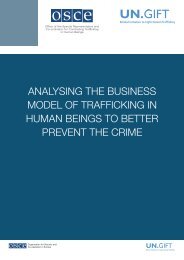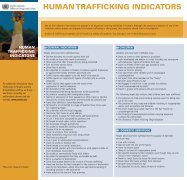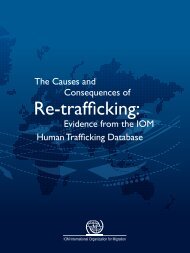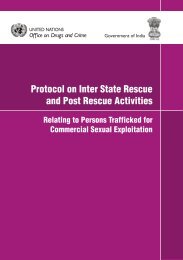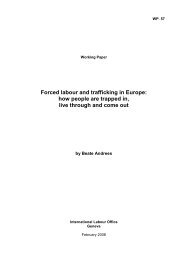An Introduction to Human Trafficking - United Nations Office on ...
An Introduction to Human Trafficking - United Nations Office on ...
An Introduction to Human Trafficking - United Nations Office on ...
You also want an ePaper? Increase the reach of your titles
YUMPU automatically turns print PDFs into web optimized ePapers that Google loves.
AN INTRODUCTION TO HUMAN TRAFFICKING: VULNERABILITY, IMPACT AND ACTION<br />
3. Facilities for migrants that protect them from abuse<br />
While some trafficking victims are under the c<strong>on</strong>trol of traffickers from the time they leave<br />
home <strong>on</strong>wards, many others fall under their c<strong>on</strong>trol later <strong>on</strong>, sometimes after arriving at<br />
a destinati<strong>on</strong> where they intend <str<strong>on</strong>g>to</str<strong>on</strong>g> find work. For many decades, some countries have<br />
made a range of facilities available <str<strong>on</strong>g>to</str<strong>on</strong>g> recently arrived migrants, in particular migrant<br />
women and children, which have helped keep them out of the c<strong>on</strong>trol of criminals who<br />
would abuse them. These include safe accommodati<strong>on</strong> and drop-in centres where recent<br />
migrants can obtain advice and informati<strong>on</strong>, such as those established in Kunming, the<br />
capital of China’s Yunnan Province. 34<br />
4. Using the law <str<strong>on</strong>g>to</str<strong>on</strong>g> tackle demand for the labour or services of<br />
trafficked pers<strong>on</strong>s<br />
In the last few years there has been debate about what preventive acti<strong>on</strong> is effective in<br />
reducing “demand” in places where trafficked people are exploited. This means implementing<br />
measures that are likely <str<strong>on</strong>g>to</str<strong>on</strong>g> reduce demand for products made by trafficked pers<strong>on</strong>s<br />
and services provided by them, which may subsequently result in fewer people being<br />
trafficked.<br />
In her 2006 report <str<strong>on</strong>g>to</str<strong>on</strong>g> the <str<strong>on</strong>g>United</str<strong>on</strong>g> <str<strong>on</strong>g>Nati<strong>on</strong>s</str<strong>on</strong>g> Commissi<strong>on</strong> <strong>on</strong> <str<strong>on</strong>g>Human</str<strong>on</strong>g> Rights, the then Special<br />
Rapporteur <strong>on</strong> <str<strong>on</strong>g>Trafficking</str<strong>on</strong>g> in Pers<strong>on</strong>s, Especially Women and Children, Sigma Huda, examined<br />
whether people who paid for the services of trafficking victims could be influenced<br />
<str<strong>on</strong>g>to</str<strong>on</strong>g> reduce the numbers of trafficked pers<strong>on</strong>s. It is notable that the treatment of demand<br />
as it relates <str<strong>on</strong>g>to</str<strong>on</strong>g> sex trafficking is somewhat different from that for other forms of exploitati<strong>on</strong><br />
and the Special Rapporteur’s report focused <strong>on</strong> demand for commercial sex, c<strong>on</strong>cluding<br />
that prostituti<strong>on</strong> was inextricably linked <str<strong>on</strong>g>to</str<strong>on</strong>g> human trafficking and that demand for<br />
commercial sex was tantamount <str<strong>on</strong>g>to</str<strong>on</strong>g> demand for the services of trafficked women and girls.<br />
She recommended that prostituti<strong>on</strong> not be legalized or decriminalized. 35 This c<strong>on</strong>trasted<br />
with comments by the Special Rapporteur <strong>on</strong> violence against women, its causes and c<strong>on</strong>sequences,<br />
Radhika Coomaraswamy, who in 2000 criticized efforts <str<strong>on</strong>g>to</str<strong>on</strong>g> abolish prostituti<strong>on</strong><br />
by targeting and punishing third-party involvement. This Rapporteur noted that, although<br />
targeting third parties such as men and boys who paid for sex appeared in theory <str<strong>on</strong>g>to</str<strong>on</strong>g> protect<br />
women sex workers from being penalized, in practice women had suffered “the burden<br />
of criminalizati<strong>on</strong>”, even when laws were intended primarily <str<strong>on</strong>g>to</str<strong>on</strong>g> target procurers, pimps<br />
and men and boys who paid for sex. 36 While prop<strong>on</strong>ents <strong>on</strong> both sides of the debate hold<br />
tenaciously <str<strong>on</strong>g>to</str<strong>on</strong>g> their c<strong>on</strong>victi<strong>on</strong>s, there remains no c<strong>on</strong>clusive link between legalizati<strong>on</strong> or<br />
criminalizati<strong>on</strong> of prostituti<strong>on</strong> and the existence of trafficking for sexual exploitati<strong>on</strong>.<br />
Further research is needed <strong>on</strong> this <str<strong>on</strong>g>to</str<strong>on</strong>g>pic.<br />
34<br />
Internati<strong>on</strong>al Programme <strong>on</strong> the Eliminati<strong>on</strong> of Child Labour (IPEC) Task Team of the Yunnan Provincial<br />
Statistics Bureau, The Mek<strong>on</strong>g Challenge: <str<strong>on</strong>g>An</str<strong>on</strong>g>alysis Report of the Baseline Survey for the TICW Project Phase II in Yunnan<br />
Province (Bangkok, Internati<strong>on</strong>al Labour <str<strong>on</strong>g>Office</str<strong>on</strong>g>, 2005).<br />
35<br />
E/CN.4/2006/62, chap. II. “Demand for commercial sexual exploitati<strong>on</strong> and trafficking”.<br />
36<br />
E/CN.4/2000/68, para. 24.<br />
118


